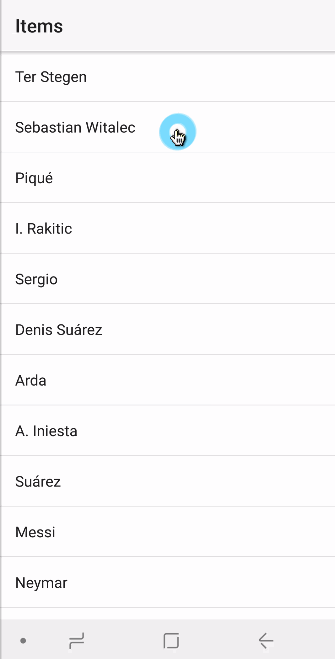How to Extend Custom Router Reuse Strategy
Implementing a Custom Route Reuse Strategy, is not only the best solution, but it is also simple and quite elegant. You can very easily add the noReuse flag to any path you don't want to reuse, while keeping it for all the other paths.
Every now and then I am asked to help with various NativeScript challenges. I wanted to share the last one - which came up few times in the past. The issue was as follows:
The Challenge
I have a Newspaper type Angular Master-Detail app. The Master page displays a list of articles to read. When you tap on one of the articles, then the app navigates - with a fancy page transition - passing an articleID to the Details page.
And here is the twist. In the Details page my app displays other related articles. When the user taps on another article, the app re-navigates to the Details page with the new articleId. At this point I can retrieve the new articleId and load the new article. However - and here is the problem - because the app navigates to the same component I cannot use page transition, and also on iOS the back button in the ActionBar still points to the Master page.
What is happening?

Before anyone starts a new Twitter war, this is the expected behaviour. Let me explain:
Creating a new Component comes with a cost, as it requires a significant number of processing cycles to create the page and each Native UI Component that goes with it. So, ideally we should want to avoid that when possible.
One case where you want to avoid creating a new Component in a mobile app is when you navigate back to the previous page (i.e. from Details back to Master). In this scenario, you want your app to navigate fast and without any delays.
To achieve that we needed to implement a Custom Router Reuse Strategy (CRRS). The thing is that the default CRRS provided by Angular, automatically reuses components when they re-navigate to themselves... hence the challenge.
You can read more about it in the Angular docs.
First Instinct - The Hack

My first instinct was to create a quick hack. If navigating from a DetailComponent to DetailComponent causes the problem, then why not create a copy of the same component and make the navigation from DetailA to DetailB to DetailA to...
Something like this:
export class ItemDetailComponent implements OnInit {
protected container = 'a';
private item: Item;
get detailsPath(): string {
return (this.container === 'a') ? '/item-b' : '/item-a';
}
constructor(protected itemService: ItemService, protected route: ActivatedRoute, protected router: RouterExtensions) { }
ngOnInit(): void {
const id = +this.route.snapshot.params['id'];
this.item = this.itemService.getItem(id);
}
navigate(id: number) {
this.router.navigate([this.detailsPath, id]);
}
}
@Component({
selector: 'ns-details-a',
moduleId: module.id,
templateUrl: './item-detail.component.html',
})
export class ItemDetailComponentA extends ItemDetailComponent {
constructor(itemService: ItemService, route: ActivatedRoute, router: RouterExtensions) {
super(itemService, route, router);
this.container = 'a';
}
}
@Component({
selector: 'ns-details-b',
moduleId: module.id,
templateUrl: './item-detail.component.html',
})
export class ItemDetailComponentB extends ItemDetailComponent {
constructor(itemService: ItemService, route: ActivatedRoute, router: RouterExtensions) {
super(itemService, route, router);
this.container = 'b';
}
}
The full hack
See the full example in Playground.
Conclusion to the hack
Even though this works, it is not a great solution, it is a great hack, but not a great solution. Most of all:
- your code becomes bloated,
- tries to trick the framework into doing something else,
- in 2 weeks you won't even remember why you did that,
- it probably causes more issues than it solves.

What if you have more than one details component like that? Are we going to start questioning whether Angular and NativeScript are the right frameworks for the job that we need them for?

"Custom" Custom Route Reuse Strategy - The proper solution
Then I talked to Alex Vakrilov from the NativeScript Core team... and he said:

OK, so back to the drawing board. Instead, we should extend the existing Custom Route Reuse Strategy, and make it fulfil the requirements of our app.
Configure Paths - noReuse flag
First, in the Routes configuration, we need to add a flag, that will help us identify, which paths shouldn't be reused. In our case this is the DetailComponent. This can be done be adding the data: { noReuse: true } to the details path. Like this:
app-routing.module.ts
const routes: Routes = [
{ path: '', redirectTo: '/items', pathMatch: 'full' },
{ path: 'items', component: ItemsComponent },
{ path: 'item/:id', component: ItemDetailComponent, data: { noReuse: true } },
];
Then each time the app navigates, we will be able to look for the noReuse flag.
Create a new Custom Route Reuse Strategy
Next, we need to create a new Custom Route Reuse Strategy class.
It should extend the NSRouteReuseStrategy:
export class CustomRouteReuseStrategy extends NSRouteReuseStrategy {
Use the Dependency Injection to get NSLocationStrategy, and pass it to the parent constructor:
constructor(location: NSLocationStrategy) {
super(location);
}
Finally, it should implement the shouldReuseRoute function, which should return true or false:
shouldReuseRoute(future: ActivatedRouteSnapshot, current: ActivatedRouteSnapshot): boolean {
// return (shouldIReuse) ? true : false;
}
Implementing shouldReuseRoute()
This is where we need to focus on the proper solution.
We MUST ALWAYS call shouldReuseRoute() from the parent, as it used to mark the activated routes that are page-specific, and also the result will let us know when it intends to reuse the current route.
let shouldReuse = super.shouldReuseRoute(future, current);
If shouldReuse is true, then we are possibly in the scenario when we are about to re-navigate from our ItemDetailComponent to itself. At this point, we need to check if the noRouse flag is set to true. And if it is, then the app is about to navigate from ItemDetailComponent to itself. To avoid reusing this path just change shouldReuse to false.
if (shouldReuse && current.data.noReuse) {
shouldReuse = false;
}
Finally, we need to return the shouldReuse value.
return shouldReuse;
Here is the full custom-route-reuse-strategy.ts
import { Injectable } from '@angular/core';
import { ActivatedRouteSnapshot } from '@angular/router';
import { NSLocationStrategy } from 'nativescript-angular/router/ns-location-strategy';
import { NSRouteReuseStrategy } from 'nativescript-angular/router/ns-route-reuse-strategy';
@Injectable()
export class CustomRouteReuseStrategy extends NSRouteReuseStrategy {
constructor(location: NSLocationStrategy) {
super(location);
}
shouldReuseRoute(future: ActivatedRouteSnapshot, current: ActivatedRouteSnapshot): boolean {
// first use the global Reuse Strategy evaluation function,
// which will return true, when we are navigating from the same component to itself
let shouldReuse = super.shouldReuseRoute(future, current);
// then check if the noReuse flag is set to true
if (shouldReuse && current.data.noReuse) {
// if true, then don't reuse this component
shouldReuse = false;
}
console.log(`Should Reuse: ${shouldReuse}`);
return shouldReuse;
}
}
Provide the new CRRS in AppModule
The last step is to let Angular know that we want to use our new CustomRouteReuseStrategy.
This is done by adding our new CRRS class as RouteReuseStrategy to the AppModule, like this:
app.module.ts
@NgModule({
...
providers: [
{
provide: RouteReuseStrategy,
useClass: CustomRouteReuseStrategy
}
],
...
})
The full solution
You can see the full solution in Playground.

Conclusion

As you can see, implementing a Custom Route Reuse Strategy, is not only the best solution, but it is also simple and quite elegant. You can very easily add the noReuse flag to any path you don't want to reuse, while keeping it for all the other paths.
Let us know in comments what you think.
Did you face this challenge before?
Are there any scenarios that this doesn't cover?